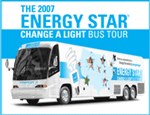It’s holiday time again, which means you’re probably going to buy at least one gift for someone, as well as items for celebrations and holiday meals. You may wish to consult Consumer Reports Greener Choices web site, which provides information to help choose more environmentally friendly products. Articles and “green ratings” are available for the following product categories: Appliances, Cars, Electronics, Food & Beverages, and Home & Garden. Within these sections, you’ll find links to articles, information on conservation of resources (such as energy, water, fuel, etc.), resources for shopping greener, and information on recycling and disposal. The “Hot Topics & Solutions” section of the site includes the Eco-labels Center (which helps you interpret what product labels really mean), the Electronics Recycling Center, the Global Warming Solutions Center, and sections on Energy, Water, and Waste.
The “Toolkit” section includes calculators to help save energy, water, and money, as well as a Toxics Search tool to find out whether there’s a potential for exposure while using a particular product, and how that can affect your health. The “Community” section of the site includes links to Consumers Union campaigns, forums and resources for further information, as well as blogs on cars, food safety, green homes, and safety.

 Wisconsin’s energy efficiency and renewable energy initiative, is currently offering
Wisconsin’s energy efficiency and renewable energy initiative, is currently offering  On October 3, 2007, U.S. EPA Administrator Stephen L. Johnson kicked off a 10-city, 20-day Energy Star Change-a-Light Bus Tour at Disneyland. EPA and the Department of Energy are sponsoring the tour to raise awareness of the benefits of energy efficient lighting choices. At each tour stop, an outdoor education center will be set up with interactive displays on the importance of our lighting choices, how to use and dispose of compact fluorescent lamps (CFLs) responsibly, and the connection between our personal energy use and our climate. According to EPA, Energy Star qualified light bulbs use 75 percent less energy than standard incandescent bulbs, and last six to ten times longer. See the
On October 3, 2007, U.S. EPA Administrator Stephen L. Johnson kicked off a 10-city, 20-day Energy Star Change-a-Light Bus Tour at Disneyland. EPA and the Department of Energy are sponsoring the tour to raise awareness of the benefits of energy efficient lighting choices. At each tour stop, an outdoor education center will be set up with interactive displays on the importance of our lighting choices, how to use and dispose of compact fluorescent lamps (CFLs) responsibly, and the connection between our personal energy use and our climate. According to EPA, Energy Star qualified light bulbs use 75 percent less energy than standard incandescent bulbs, and last six to ten times longer. See the